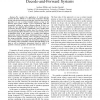Free Online Productivity Tools
i2Speak
i2Symbol
i2OCR
iTex2Img
iWeb2Print
iWeb2Shot
i2Type
iPdf2Split
iPdf2Merge
i2Bopomofo
i2Arabic
i2Style
i2Image
i2PDF
iLatex2Rtf
Sci2ools
119
click to vote
WCNC
2010
IEEE
2010
IEEE
Switch-And-Stay Transmit Diversity for Cooperative Decode-And-Forward Systems
—We consider the application of switch-and-stay transmit diversity (SSTD) to a three-node cooperative diversity system with decode-and-forward relaying. The basic idea of SSTD generally is to use a certain transmit antenna as long as the induced signal quality satisfies a given requirement while the transmitter switches to another antenna element if this is no longer the case. Applying this principle to the source node of a cooperative diversity system is significantly more complex than for conventional single-hop systems since the selected antenna element generally affects both the source-to-relay and the sourceto-destination link. In this regard, we consider three different approaches, namely relay-driven, destination-driven, as well as jointly-driven optimal switching, always targeting at minimizing the outage probability between source and destination. For all cases, we determine exact analytical closed-form expressions for the resulting outage probability assuming Rayleigh-fad...
Related Content
| Added | 31 Jan 2011 |
| Updated | 31 Jan 2011 |
| Type | Journal |
| Year | 2010 |
| Where | WCNC |
| Authors | Andreas Müller, Joachim Speidel |
Comments (0)

